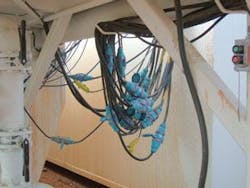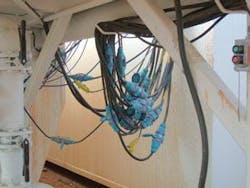Rig moves have become safer for Saber Industries LP since it started using combination receptacles that allow workers safely to make and break electrical connections, even under full load.
Saber also says that the receptacles, when used as switches, conform to the National Electric Code (NEC) required line-of-sight disconnect requirement.
Saber, headquartered in Seminole, Okla., operates eight drilling and service rigs capable of working up to 7,700-12,000 ft.
The Meltric Corp. decontactors connect 440-v AC electric motors, pumps, and other equipment on its rigs (photo).
Rig moves
Saber says its rigs are moved frequently from one site to another, typically every 2 weeks to 1 month. Every time a rig moves, workers must disconnect and then reconnect motors, lights, heaters, washers, and other equipment. They may also have to break connections during rig operations to maintain or repair equipment.
The company previously used metal pin-and-sleeve connectors for 480-v and 110-220 v single-phase circuits. Saber says because of frequent washdowns, the pin-and-sleeve connectors posed some safety problems, such as when the plugs were washed down. If water got into them, they would blow apart, and if someone touched the plug while standing on wet ground, he could be killed, according to the company.
The connectors were also expensive to replace, the company added.
New decontactors
The company started installing the Meltric decontactors about 1 year ago and currently has installed them on three of its largest rigs.
The decontactors incorporate spring-loaded, silver-nickel butt-style contacts that provide consistent electrical performance during thousands of operations and resist wear, corrosion, oxidation, and other forces that contribute to premature failure of the pin-and-sleeve-type devices, according to Saber.
To disconnect a motor, one must initially press a pawl on the decontactor that breaks the circuit and ejects the plug to its rest position. Then, a quarter-turn of the plug allows it to be withdrawn totally and safely from the receptacle because the circuit is already dead. When the plug and receptacle are separated, a safety shutter prevents access to live parts.
Saber says that in some cases, it uses the plugs as a line-of-sight disconnect switch, particularly for such low-voltage applications as fuel pumps.
In this mode, if work is needed on a fuel pump, one can disconnect the plug and then keep the decontactor in sight so that someone else does not turn it back on. With decontactors, provisions for locking out the plug are standard, so that one only needs a lock and tag to comply with lockout-tagout requirements.
Saber has installed decontactors on motors ranging from 7½ to 60 hp, as well as on all other electrical equipment. A rig may have 18 low-voltage and 30 high-voltage circuits with multiple places to break the circuit, so that there are many decontactors on a rig.
The decontactors also have color-coded terminals and modular construction to simplify connections. Other features include watertight rubber gaskets that fit different cable sizes.
To prevent misconnections, the manufacturer can configure the contact arrangement so that it will only connect with a designated receptacle.

